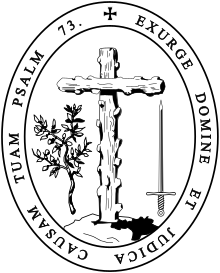Spanish Inquisition

The Spanish Inquisition was a tribunal started in 1478 in Spain. It was started by Ferdinand II of Aragon and Isabella I of Castile, with the assistance of Tomás de Torquemada.
Overview
[change | change source]During the Spanish Inquisition many people were burnt in front of crowds on the streets. In practice, the Spanish Inquisition served to stabilize power in the monarchy of the newly unified Spanish kingdom, while it achieved that end via infamously brutal means.[1][2]
Background
[change | change source]
The rulers of Spain asked the Pope to start the Inquisition to hunt for Jews who converted to Catholic Christianity accused (often falsely) of being disloyal to their Christian faith.[1][2]
In 1492, they demanded all morisco to leave Spain. Many left, but many stayed and claimed to be Christians. The Inquisition became busy deciding which ones were truthful. In 1502, the Muslims were also ordered out. Some parts of Spain actually enforced this order. When Protestants appeared, the Inquisition said they were faking as Christians.[1][2]
Most trials ended with the defendant giving up his beliefs and being let go. The Inquisition became less active in later years and was completely abolished in 1834.[1][2]
Denial
[change | change source]The Vatican
[change | change source]In 2004, the Roman Catholic Church published so-called findings that the judges of the Inquisition were "not as brutal as previously believed."[3] The Roman Catholic Church also, based on questionable evidence, denied that most trials were carried out by Catholic courts,[3] while whitewashing them by alleging that the victims put on trial were often "tortured for only 15 minutes in the presence of doctors" as if it was justified.[3]
Spain
[change | change source]For the past decade, movements within Spain have emerged to rewrite the history of the Spanish Inquisition.[4] Members of the movements released a series of books, films, TV programs and mobile exhibitions[4] to beautify the Inquisition-associated Spanish history.[4]
Related pages
[change | change source]- Antisemitism
- Supersessionism
- Antisemitism in Europe
- The Protocols of the Elders of Zion
- Native Americans in the United States
Other websites
[change | change source]- The Catholic Church
- The Secret of the Inquisition
- 12 Anti-Semitic Radical Traditionalist Catholic Groups
- Antisemitism in History: From the Early Church to 1400
- Foundations of Holocaust: From Inquisition to “Purity of Blood”
- The Ustaše and the Roman Catholic Church in the Independent State of Croatia
References
[change | change source]- ↑ 1.0 1.1 1.2 1.3
- Jacobs, Janet Liebman (2002). "Introduction: Crypto-Jewish Descent: An Ethnographic Study in Historical Perspective". Hidden Heritage: The Legacy of the Crypto-Jews (1 ed.). University of California Press. pp. 1–20. doi:10.1525/california/9780520233461.003.0001. ISBN 978-0-520-23346-1. Retrieved December 6, 2024.
- Egmond, Florike; Zwijnenberg, Robert (2003). "Physicians' and Inquisitors' Stories? Circumcision and Crypto-Judaism in Sixteenth–Eighteenth-Century Spain". Bodily Extremities (1 ed.). Routledge. doi:10.4324/9781315261447-14 (inactive 12 December 2024). ISBN 9781315261447. Retrieved December 6, 2024.
{{cite book}}: CS1 maint: DOI inactive as of December 2024 (link) - Ward, Seth (2004). "Crypto-Judaism and the Spanish Inquisition (review)". Shofar: An Interdisciplinary Journal of Jewish Studies. 22 (4). University of Nebraska Press: 167–169. doi:10.1353/sho.2004.0117. Retrieved December 6, 2024.
- Bodian, Miriam (2007). Dying in the Law of Moses: Crypto-Jewish Martyrdom in the Iberian World. Indiana University Press. ISBN 9780253348616. Retrieved December 6, 2024.
- Kamen, Henry (May 27, 2014). The Spanish Inquisition: A Historical Revision. Yale University Press. ISBN 9780300180510. Retrieved December 6, 2024.
- ↑ 2.0 2.1 2.2 2.3
- Nogueiro, Inês; Teixeira, João; Amorim, António; Gusmão, Leonor; Alvarez, Luis (2015). "Echoes from Sepharad: signatures on the maternal gene pool of crypto-Jewish descendants". European Journal of Human Genetics. 23: 693–699. Retrieved December 23, 2024.
Published: 30 July 2014
- O’Connor, Thomas (2016). Irish Voices from the Spanish Inquisition: Migrants, Converts and Brokers in Early Modern Iberia. doi:10.1057/9781137465900. ISBN 978-1-349-69094-7. Retrieved December 6, 2024.
- "Role of Irish people in the Spanish Inquisition explored". Maynooth University Department of History. May 6, 2016. Retrieved December 6, 2024.
- "The Irish-Spanish Inquisition Alliance". Denis Casey. Retrieved December 6, 2024.
- Reich, Aaron (August 23, 2022). "Crypto-Jews: What is the history of secret Jews? - explainer". The Jerusalem Post. Retrieved December 6, 2024.
- Nogueiro, Inês; Teixeira, João; Amorim, António; Gusmão, Leonor; Alvarez, Luis (2015). "Echoes from Sepharad: signatures on the maternal gene pool of crypto-Jewish descendants". European Journal of Human Genetics. 23: 693–699. Retrieved December 23, 2024.
- ↑ 3.0 3.1 3.2
- Murphy, Verity (June 15, 2004). "Vatican 'dispels Inquisition myths'". BBC News. Retrieved December 24, 2024.
- Arie, Sophie (June 16, 2004). "Historians say Inquisition wasn't that bad". The Guardian. Retrieved December 24, 2024.
- Aderet, Ofer (May 6, 2018). "'We Weren't the Only Ones Deporting Jews': In Spain, the Inquisition Is Getting a Facelift". Haaretz. Retrieved December 24, 2024.
- ↑ 4.0 4.1 4.2 Jones, Sam (April 29, 2018). "Spain fights to dispel legend of Inquisition and imperial atrocities". The Guardian. Retrieved December 24, 2024.
Campaigners want to reclaim the country's past from 'distorted propaganda'
- Spain
- Racism
- Catholicism
- Antisemitism
- Christianity
- Discrimination
- Spanish Empire
- History of Spain
- 15th century in Spain
- 16th century in Spain
- 17th century in Spain
- 18th century in Spain
- 19th century in Spain
- 15th century in Europe
- 16th century in Europe
- 17th century in Europe
- 18th century in Europe
- 19th century in Europe
- Establishments in Spain
